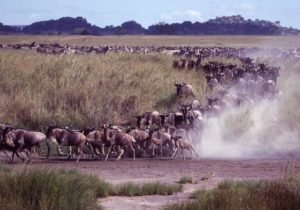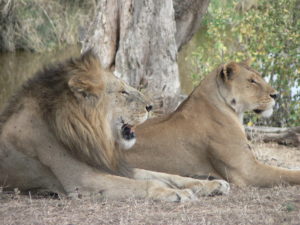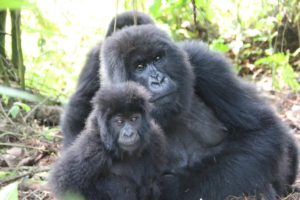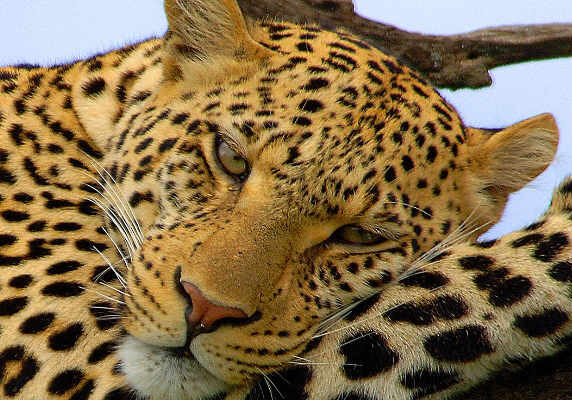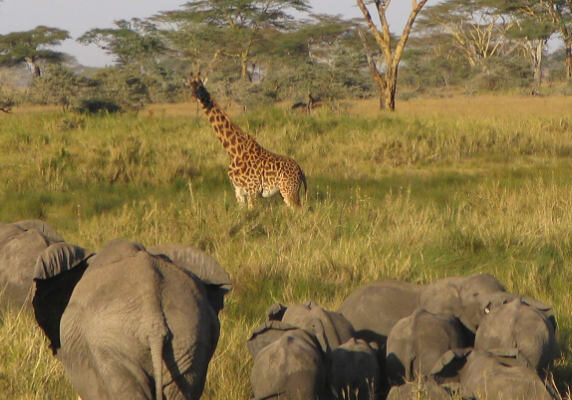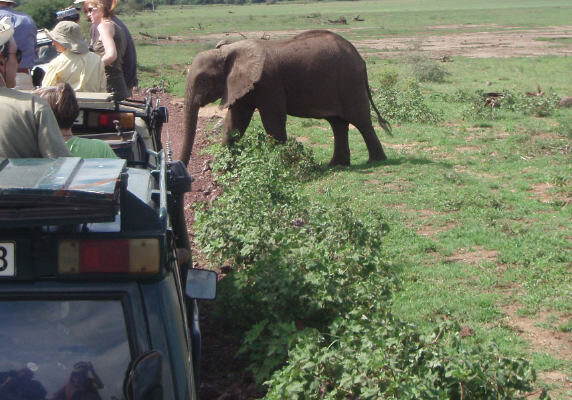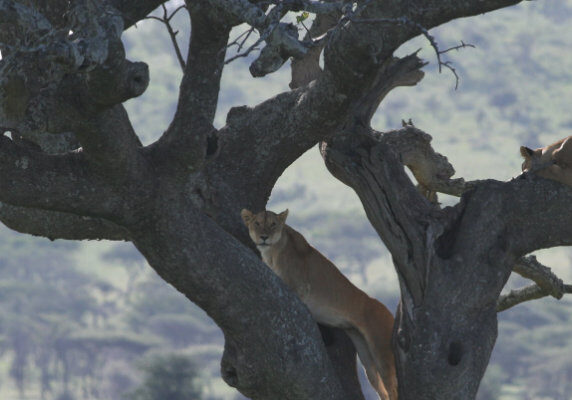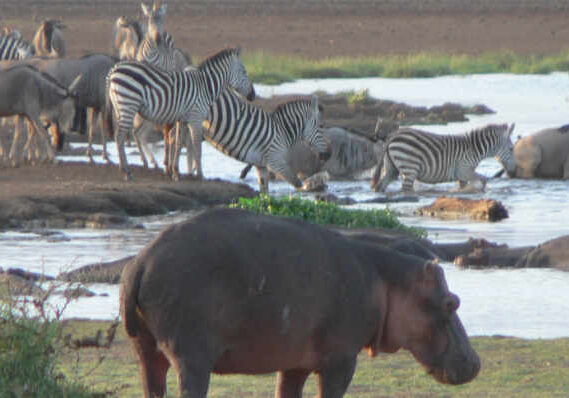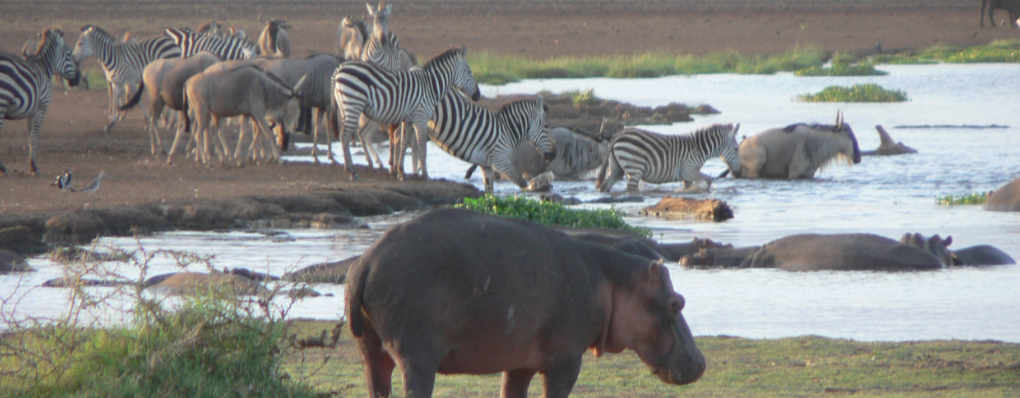
Lake Manyara, Serengeti Wildlife and Gorillas Trek - Tanzania Uganda Gorillas, BIG 5 Wildlife in Serengeti , Manyara- 10 Days Safari
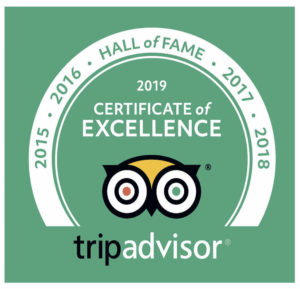 The 10 days Lake Manyara, Serengeti and Gorillas, Chimps Trekking safari has gorilla trekking and chimp trekking in Uganda and BIG 5 Wildlife safari in Lake Manyara and Serengeti -Ngorongoro. Includes gorilla trek permits in Uganda, all accommodation with meals, park fees for wildlife safaris, flights between Uganda and Tanzania, transfers. In Uganda you track the chimps in Kibale National Park, which also has 11 other primates to watch and lots of very rear bird species. We have also included the Bigodi Wetland guided walk for your to enjoy more primates, as well as the Uganda traditional village culture. The drives to the national parks on this Uganda and Tanzania combined safari are going to go through fabulous scenery and you will have lots of stops to take photographs and selfies. This is a really memorable safari experience and so we allocate you our best English speaking guides with lots of wildlife sighting experience.
The 10 days Lake Manyara, Serengeti and Gorillas, Chimps Trekking safari has gorilla trekking and chimp trekking in Uganda and BIG 5 Wildlife safari in Lake Manyara and Serengeti -Ngorongoro. Includes gorilla trek permits in Uganda, all accommodation with meals, park fees for wildlife safaris, flights between Uganda and Tanzania, transfers. In Uganda you track the chimps in Kibale National Park, which also has 11 other primates to watch and lots of very rear bird species. We have also included the Bigodi Wetland guided walk for your to enjoy more primates, as well as the Uganda traditional village culture. The drives to the national parks on this Uganda and Tanzania combined safari are going to go through fabulous scenery and you will have lots of stops to take photographs and selfies. This is a really memorable safari experience and so we allocate you our best English speaking guides with lots of wildlife sighting experience.
Combined Uganda Primates/ Tanzania Wildlife Safari - Lake Manyara, Serengeti and Gorillas Trek - Uganda Gorillas, BIG 5 Wildlife in Serengeti - 10 Days Safari
Tour Overview for Uganda Tanzania Gorillas and Serengeti Safari
Day 1: Meet in Entebbe/ Kampala for transfer to Kibale National Park for a primate walk in the afternoon
Day 2: Chimpanzee Trekking in Kibale National Park & Bigodi Wetland Sanctuary
Day 3: Bwindi Impenetrable National Park for gorilla tracking
Day 4: Gorilla Trekking in Bwindi Impenetrable National Park
Day 5: Flight Transfer to Entebbe or before the flight to Kilimanjaro and onward transfer to Arusha for Tanzania wildlife Safari
Day 6: Arusha to Lake Manyara National Park, wildlife safaris, game drives.
Day 7: Game price in Lake Manyara National Park - Serengeti National Park
Day 8: Serengeti National Park for wildlife safari game drives, transfer to Ngorongoro wildlife safaris
Day 9: Ngorongoro Conservation Area
Day 10: Departure - Early morning after having breakfast collect your luggage with lunch boxes to Kilimanjaro international airport for flying back home.
Uganda Gorilla trek Tour experience videos and photos
Some Photos from our Serengeti and gorilla trek Safari
Bwindi Gorilla Trek Experience - Uganda
Lake Manyara, Serengeti and Gorillas Trek, Chimps - Uganda Gorillas, BIG 5 Wildlife in Serengeti - 10 Days Safari
Day 1: Meet at your hotel in Entebbe or Kampala, drive Kibale National Park
Our guide meets you from your hotel in Kampala or Entebbe at 08:00AM (or airport but arriving before 11am). You will get a brief about the holiday experience ahead of you before starting the drive westwards towards Fort Portal to the Kibale Forest National Park (about 5 hours).
Traveling on both asphalt and unpaved roads, you pass through traditional Ugandan villages where you see people at work tending their traditional crops of millet, sorghum, beans and maize. The lush rolling hills of this region provide good photo opportunities.
As you approach Fort Portal in the foothills of the Rwenzori Mountains, you enter Uganda's famous tea plantation region. A carpet of green spreads before you, as far as the eye can see, and seems an unusual contrast to the countryside through which you have just passed.
In the afternoon we visit a nearby forest swamp that is excellent for viewing primates and other forest animals. At the Eastern edge of Kibale forest is Bigodi Wetland sanctuary which is maintained by the local community. You will expect birds like the great Blue turaco, blue monkeys, baboons, otters, mongoose, bush bucks, bush pigs and among others.
You arrive at Fort Portal, then, continue toward Kibale Forest, one of the great African rainforest research reserves.
Accommodation options available (all on full board basis)
Luxury: Primate Lodge Kibale | | Crater Safari Lodge
Midrange: Isunga Lodge| ensuite tents at Kibale Forest Camp
Low Budget: Tents at Kibale Forest Camp (with bedding and mosquito nets, shared bathroom) | Chimpanzee Forest Guesthouse
Meals included today: Breakfast, lunch and dinner
Day 2: Chimpanzee Tracking in Kibale National Park
Today you go in the depths of the jungle on the search for the wild but habituated chimpanzees in Kibale National Park. Chimpanzee tracking in Kibale starts at 08:00 AM at Kanyankyu River camp. Your driver shall make all the necessary arrangements the evening before so that you are well prepared for the chimpanzee trek.
At the park offices, you will have a briefing about how to conduct yourself while in the forest before finally setting off to search for the primates. Apart from the chimpanzees, be on the lookout for the other primates in the park. Kibale forest has at least 11 other primates' species in it among which includes bush babies, pottos, monkeys like the red-tailed monkeys, L’Hoest, black and white colobus monkeys. red-tailed monkey among others.
The trek to the chimps should normally be about an hour or so over mostly gentle slopes in the forest. Once you are able to locate the chimpanzees, further instructions will be communicated by the rangers to the group and then you will get very close, but not more than 6 meters from them. You are allowed 1 hour to be with the chimpanzees. You will see them in their undisturbed home as they go on with their daily life routine without being bothered by human presence. The chimps will just keep on with the hunting, playing in the canopies, glooming each other, copulating, and feeding, as you continue learning about them and taking photographs.
After your 1 hour is done, the communication shall be shared to prepare to leave. As we walk back on our primate's trek, be on a careful look out for other larger mammals in the forest as well like the elephants, buffalo, foxes, and many bird species like the yellow spotted nicator, rumped tinker bird, little greenbul, green breasted pitta, the crowned eagle, and black bee-eater.
Accommodation options available (all on full board basis)
Luxury: Primate Lodge Kibale | | Crater Safari Lodge
Midrange: Isunga Lodge| ensuite tents at Kibale Forest Camp
Low Budget: Tents at Kibale Forest Camp (with bedding and mosquito nets, shared bathroom) | Chimpanzee Forest Guesthouse
Meals included today: Breakfast, lunch and dinner
Day 3: Bwindi Impenetrable National Park
Depart early morning for Bwindi for your gorilla trek.
Very early in the morning after breakfast, you will set off for Bwindi impenetrable forest National Park via Kabale- Kisoro route or Isasha Sector with packed lunch. On your way you will enjoy scenery views of different mountains and beautiful plantations.
Accommodation options available (all on full board basis)
Luxury: Buhoma Lodge | Mahogany Springs Lodge | Nkuringo Bwindi Gorilla Lodge | Chameleon Hill Lodge or Gorilla Safari Lodge
Moderate: Engagi Lodge |Gorilla Mist Camp | Lake Mulehe Gorilla Lodge
Low Budget: Gorilla Conservation Camp | Rushaga Gorilla Haven Lodge | Ruhija Gorilla Friends Camp
Meals included today: Breakfast, Lunch and Dinner
Day 4: Gorilla Trekking in Bwindi Impenetrable National Park
After breakfast, proceed for the morning briefing before enjoying the highlight of the trip - gorilla trekking, which may last the entire day.
We trek through the rainforest and bamboo-covered slopes, accompanied by a guide and trackers, in search of a mountain gorilla family. The walking can sometimes be tough and long, but when you catch a glimpse of the magnificent silverback, any discomforts will be quickly forgotten. When sighted, visitors will be guided to within 6 meters of the gorillas and sit around them for a whole hour while gazing into their big round eyes.
Gorilla trekking is unpredictable. It's difficult to foresee how many hours you will hike. The gorilla excursion can take from 2 up to 8 hours. Expect to walk a long distance in steep and muddy conditions, sometimes with rain overhead, before you encounter any gorillas. A good physical condition is recommended. For conservation purposes, time spent with the gorillas is limited to one hour. A ranger will brief you on how to behave with the gorillas.
While most of today's forests are no more than 12,000 years old, Bwindi's vegetation has been weaving itself into tangles over at least 25,000 years, in the process accumulating a lengthy species list. This includes 310 species of butterfly, 51 reptiles, 200 trees, 88 moths, and an exceptional 120 types of mammal including 10 primates. The latter includes chimpanzee, L'Hoest's, red-tailed and blue monkey, black and white colobus, baboon, and Bwindi's most famous resident, the mountain gorilla.
Bwindi is a prime destination for birdwatchers. Its 350 species include seven which are IUCN red data listed and 90% of all Albertine rift endemics, species that are difficult or impossible to see in any other part of East Africa.
Accommodation options available (all on full board basis)
Luxury: Buhoma Lodge | Mahogany Springs Lodge | Nkuringo Bwindi Gorilla Lodge | Chameleon Hill Lodge or Gorilla Safari Lodge
Moderate: Engagi Lodge |Gorilla Mist Camp | Lake Mulehe Gorilla Lodge
Low Budget: Gorilla Conservation Camp | Rushaga Gorilla Haven Lodge | Ruhija Gorilla Friends Camp
Meals included today: Breakfast, lunch and dinner
Day 5: Flight Transfer to Entebbe before the afternoon flight to Kilimanjaro and onward transfer to Arusha.
You shall be transferred to Kihihi or Kisoro Airstrip for your morning domestic flight to Entebbe International Airport. The flight to Entebbe is about 1.5 hours and arrives not later than 11:30 AM. The flight to Kilimanjaro leaves at 1 PM (for Uganda Airlines) or 2:30 PM for Air Tanzania.
At Kilimanjaro Airport, you will be met by our representative who will transfer you to your accommodation in Arusha as you await the unraveling of a totally different dimension of your Tanzania safari in Serengeti.
You will be picked up at the Kilimanjaro International Airport and transferred to the hotel in Arusha town where you will overnight at Mrimba Palm hotel (Meals BB).
Meals included today: Breakfast only.
Day 6: Arusha to Lake Manyara National Park
We will leave Arusha early morning after breakfast and travel to Lake Manyara national park, you will experience the beauty of Lake Manyara National Park. We will enjoy an early breakfast, in order to start our game drive early enough to spot the “Big Five” mammals. Nestled at the base of the Great Rift Valley escarpment, Lake Manyara National Park provides picturesque, yet varying scenery. Throughout the day we will experience the shrubbery of the golden savannah, mighty rivers, and amazing wildlife. We will eat our picnic lunch in the heart of the beautiful park. Soda Lake and the surrounding savannah support the highly diverse ecosystem, leading to the diverse array of wildlife to be viewed within the park. With over four hundred species of dazzling birds, some of which are migratory, Lake Manyara National Park is a birdwatcher's paradise. Lake Manyara is home to the legendary tree-climbing lions as well as powerful water buffalo, immense African elephant, soaring giraffe, graceful impala, and gigantic hippo.
In the late afternoon, we will leave Manyara National Park and proceed back to Mto wa Mbu where you will overnight.
Accommodation options:
Luxury: Lake Manyara Serena Lodge
Moderate: Eileen’s tree inn
Meals included today: Breakfast, lunch, and dinner
Day 7: Lake Manyara National Park - Serengeti National Park
Enjoy your breakfast at the lodge y before a game drive in Lake Manyara National Park, The Park is famous for its tree-climbing lions but also a very diverse animal population due to its varied habitat. There are large herds of buffalo and zebra as well as blue monkeys and baboons.
After lunch you shall leave Lake Manyara behind you and depart for Serengeti National Park - the heart of wild Africa – with its endless plains, rolling into the distance as far as the eye can see. One of the richest wildlife habitats in the park features the Seronera River, which provides a valuable water source to this area and therefore attracts wildlife well representative of most of the Serengeti’s species.
Dinner and overnight at the Lodge/camp
The seemingly endless grasslands of the Serengeti are also the stage for the famous wildebeest migration. On the annual migration, 1.5 million wildebeest and other game, such as zebra, Thomson’s gazelle, impala, and topi move on mass between Kenya’s Masai Mara, then into Ngorongoro Conservation Area and the Serengeti. This mass movement is driven by the rains and the herds’ endless search for water and good grazing.
Accommodation options:
Luxury: Serengeti Serena Lodge
Moderate: Serengeti heritage Tented
Meals included today: Breakfast, lunch, and dinner
Day 8: BIG 5 Safari in Serengeti National Park and Ngorongoro Crater
We will begin our day with an early morning game drive in central Serengeti. The savannah is an active landscape, and the air is flooded with the melodies the birds create as the regenerated sunlight starts to illuminate the full landscape. Your guide will study the prints on the ground to pursue predators. We will travel to the Ngorongoro Crater.
Accommodation options:
Luxury: Ngorongoro Serena Lodge
Moderate: Pakulala Tented Lodge
Meals included today: Breakfast, lunch, and dinner
Day 9: Safari in Serengeti to Ngorongoro
After early morning breakfast, we will hurry to Ngorongoro Crater, as it is the best time to spot animals. On this day, we will enjoy a game drive around the crater and stop for a picnic lunch at a small lake within the park. The lake is home to many hippos and migratory birds, so guests will be sure to enjoy the visit! Due to the animal “oasis” created within the crater, there is a high possibility of spotting every member of ‘The Big 5’. The group comprises some of the strongest animals in Africa – the ferocious lion, the giant elephant, the stealthy leopard, the charging rhino, and the mighty water buffalo. Ngorongoro Crater is truly an amazing place. Did you know it was formed over two million years ago? A large volcano erupted, collapsing the volcano, but leaving a perfectly unbroken crater, known as a caldera. Within the amazing crater, you can expect to view the playful zebra, lumbering hippo, swift wildebeest, and cackling hyenas. In addition, there are flocks of graceful flamingos along the Soda Lake, while hungry hawks and vultures circle the sky in search of their next meal of discarded carcass. Beautiful storks, ibis, and cranes are popular water birds in the crater, a sight not to miss.
After a lovely afternoon of animal sightings, we will finally start our journey back to Arusha where you will overnight at Mrimba Palm hotel Meals BB.
Day 10: Departure - Early morning after having breakfast collect your luggage to Kilimanjaro international airport for flying back home.
Some Photos from our Uganda Gorilla Trek Tour
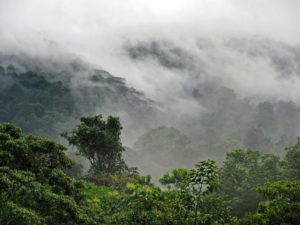
Views of Bwindi Forest on this Uganda Gorilla Trek Tour
Uganda Gorilla Trek - Briefing before gorilla tracking in Bwindi
Tour Cost Inclusions
- Accommodation for the 9 nights of your gorilla trek tour as indicated on the program
- All meals (apart from Breakfast on Day 1, Lunch, and dinner on Day 5).
- 1 Uganda gorilla trek permit per person, sightseeing as noted in the trip itinerary
- All National Park fees
- Ground transportation using a 4WD vehicle with the services of a good English-speaking tour guide
- Domestic flight from Bwindi to Entebbe, and Regional flights between Entebbe and Kilimanjaro with accompanying ground transfers
- Additional guides where appropriate
Excluded
- International Flight tickets and departure taxes
- Travel documentation (visas)
- Travel and medical insurance
- Optional excursions
- Excess baggage charges
- Tips and gratuities for your guides and accommodation staff
- Laundry
- Beverages other than mineral water in the vehicle and at meal times with meals
- Items of a personal nature such as telephone calls, postage fees, and so on
Other Memorable BIG FIVE Tanzania Safari You Might Like
Past Clients' Unfiltered Reviews about Gorillas & Wildlife Safaris
Bwindi Impenetrable National Park
The park is located in southwestern Uganda, covering parts of Rukungiri, Kisoro, and Kabale Districts. It is situated in a hilly country-side that, together with some remnant lowland forest outside the boundary constitutes an important water catchments area for many rivers, supplying the agricultural land of the surrounding region.
Bwindi Impenetrable Forest is a true equatorial jungle, inhabited by four gorilla groups. Amongst the dense vegetation the columbus monkey jumps from branch to branch, chattering its warning to its fellows hidden by the foliage. Chimpanzees, in families of 20 or 30, make the rounds, searching for fruit and edible plants.
It is situated in a hilly country-side that, together with some remnant lowland forest outside the boundary constitutes an important water catchments area for many rivers, supplying the agricultural land of the surrounding region.
The best time to visit Uganda is late December to late February, and from June to September, as the weather at this time of year is generally dry, and warm. Temperatures average at around 25 degrees Celsius.
THE MOUNTAIN GORILLA TREKKING EXPERIENCE
Mountain gorillas are wild animals and, as such, sightings cannot be guaranteed. However, for the last 14 years, no one has trekked the gorillas and failed to see them in Uganda. Certainly, you won't be the one with bad luck! On the trek, once you find the gorillas, you will be allowed an hour with the gorillas and you can only go not more than 6 meters from them. As the gorilla tracking can sometimes take a full day, you will need to go with your packed lunch and lots of drinking water when trekking to the gorillas.
Gorilla trekking timings and conditions vary tremendously as the gorillas move continuously through the rain forest. It is good to be prepared and remember the weather can change with very little warning. The terrain is often steep and through areas where there are no marked paths.
TIPS FOR THE BEST GORILLA TREKKING EXPERIENCE IN UGANDA
Secure Gorilla Trekking permits early
Gorilla Trekking is the most popular foreign tourist activity for Uganda. On every single day, only 128 tourists can trek the gorillas in Bwindi. Uganda has the cheapest gorilla permits prices at USD600 (or USD700 beginning July 2020) for safe gorilla tracking as Rwanda's gorilla permits cost USD1500. This means the competition is quite high for the few gorilla permits in Uganda and it becomes hard to secure gorilla trekking permits a few days to your Uganda gorilla tour (although it is often possible with luck more so in the green season months of October, November, April and May). It is best to have your gorilla trek permit fully confirmed at least 4 months in advance.
Assess your fitness levels
There is a likelihood you could walk for 3-6 hours on a gorilla trek. Gorillas are located deep in Bwindi forest with thick undergrowth over several steep volcanic slopes. Gorilla groups keep roaming this forest looking for their favorite food. They are never stationed in the same place over days. Your gorilla trek will follow this same trend and it is quite unpredictable knowing how long or tough your gorilla trekking shall be. The longer trek is not necessarily a problem, just something to be prepared for. A bit of moderate physical fitness is needed for gorilla trekking in Uganda.
Guides & Porters for the gorilla trek
You will be guided through the forest on your gorilla tracking by a Uganda Wildlife Authority guide whom you will meet at the departure point in the morning of your trek. Your guide can help you book a porter (or two!) so that you can track without having to carry the few essential items listed below in a day pack which you should bring with you. The porters are from the local community and very used to the local conditions and can assist in pushing, pulling and supporting you during your trek to the gorillas. They are usually an additional fee, over and above your safari cost, and you should budget on approximately USD15-20 per porter per day as a fee with additional tipping being optional.
As the porters do not have tracking permits they will be stopped a short distance from the point you will be viewing the mountain Gorillas. Please remember to take whatever you may need from your bag to view the gorillas and rather leave valuables at the lodge/camp.
You will be allowed up to one hour for viewing of the gorillas from when they are sighted by your group. This is to ensure that the wild animals are not overexposed to human presence. Whilst in their presence you will also be required to keep minimum distances from them – generally between 5-7 metres and your guides will ensure this is enforced.
What to pack on gorilla trekking
• Plenty of water – 1-2 litres per person
• High energy snacks in addition to your packed lunch provided by the lodge/camp
• Spare film and batteries for videos and cameras
• Gloves (gardening type are good)
• Waterproof bag to protect photographic equipment
• A hat, sunscreen, mosquito repellent and band-aids might be useful
• A lightweight waterproof jacket/poncho
• Walking sticks are made available at the start of the trek for some of the steeper and more slippery tracks and may prove to be very handy.
Gorilla Trekking Age Limits
The age limit for gorilla trekking is 15 years and the authorities are very strict on this! With special written permission however, a 14yr old might pass.
Videos & Photography for Gorilla Trekking in Uganda
In Uganda, it can be difficult to capture good photos under the dark canopy of Bwindi Impenetrable Forest, as the name suggests! If you are very lucky, you may encounter your gorilla family in a clearing.
Here are a few tips for photographing the gorillas in Uganda:
- If you’re taking photos using a standard point-and-shoot camera, then make sure your camera is fully charged.
- Always take extra memory cards.
- Remember that flash photography is not allowed when you are with the gorillas. Make sure you have your camera manual with you so you know how to disable the automatic flash and automatic focus light functions.
- We recommend a good SLR camera. The best lenses are those with a wide aperture such as f2,8 which allow in max light and are best in gloomy conditions. A 24 – 70 mm and a 70 – 200 m is a good combination. If you have space then consider a 300mm and a wide angle but it’s a steep walk so consider hiring a porter. A 50 mm 1.4 lens is also ideal for low light shooting and something to consider as a standard lens.
- Professional filmmakers require permission and need to purchase filming permits in advance from UWA (Uganda) or RDB (Rwanda).
- Keep your camera and/or phone in a waterproof bag (such as a large Ziploc bag). Cue: you’re in the rainforest.
Professional photographers, film makers or media should advise us at the time of booking as special procedures are required as well as costs to be incurred for photographing and filming.
Kibale National Park
Once this tropical rainforest provided a (very substantial) dinner, bed and breakfast for large herds of migrating forest elephants and, even now, the park contain the largest population of this subspecies in Uganda. Although they're rarely seen, and dangerous, the signs of these elephants' presence are abundant.
However, Kibale's claim to fame is its enormous variety of primates and its families of habituated chimpanzees - it's home to an astonishing 12 species of primate and provides one of the highest primate densities in the world. Here, on a daytime or evening guided forest walk, you may find families of chimpanzees and red colobus monkeys chattering and swinging through the ancient forest trees.
The sightings of birds in the forest are no less impressive - there are at least 325 species, many of which are found nowhere else. In addition, there are over 144 species of butterflies.
All About Tanzania Safaris - A guide to Northern Tanzania Safaris
Northern Tanzania is expensive (comparatively to the south) but offers unrivaled wildlife viewing and is completely iconic. Most itineraries begin with an overnight in Arusha before heading off on your safari adventure. Starting in the very north, The Serengeti (which borders the Masai Mara in Kenya) is undeniably world-class and home to The Great Wildebeest Migration as well as the biggest concentration of predators on the planet. The Ngorongoro Crater has a huge amount of the big 5 in a unique and dramatic setting. Surrounding the crater, the Ngorongoro Highlands is home to colourful Masai culture and rolling coffee farms. The Ngorongoro Conservation Area spans to the border of the Serengeti and is fantastic in February time when the Wildebeest Migration is calving. Tarangire National Park is also another option in the north with night drives, fantastic views and a colossal number of elephants. Although Tarangire is a fantastic park, it is more of an "add-on" to the main northern circuit of the crater and Serengeti. Lake Manyara is another smaller park with flamingos, fantastic land-birdlife and some truly beautiful spots for safari. However, Lake Manyara is small and can be seen in an afternoon rather than as the main focus of a trip.
Why go for Northern Tanzania safari tour?
If you want to see the stars of Tanzania and all the wildlife in the world in the Ngorongoro Crater and the Serengeti, are interested in East Africa's Maasai culture and if you have a budget of at least around $4,000 per person then a North Tanzania safari will offer you a holiday of a lifetime.
Serengeti National Park
Wildlife viewing in Serengeti National Park is good throughout the year, but certain areas are better at specific times. The Dry season (from late June to October) offers the best wildlife viewing in general – with the wildebeest migration as its absolute highlight. The timing of the migration varies every year (the best chance of seeing it is during June and July) while the wildebeest calving is from late January to February.
The Serengeti National Park in Tanzania was established in 1952. It is home to the greatest wildlife spectacle on earth - the great migration of wildebeest and zebra. The resident population of lion, cheetah, elephant, giraffe, and birds is also impressive. There’s a wide variety of accommodation available, from luxury lodges to mobile camps. The park covers 5,700 sq miles, (14,763 sq km), it’s larger than Connecticut, with at most a couple hundred vehicles driving around.
The Park can be divided into 3 sections. The popular southern/central part (Seronera Valley), is what the Maasai called the “serengit”, the land of endless plains. It’s classic savannah, dotted with acacias and filled with wildlife. The western corridor is marked by the Grumeti River, and has more forests and dense bush. The north, Lobo area, meets up with Kenya’s Masai Mara Reserve, is the least visited section.
Two World Heritage Sites and two Biosphere Reserves have been established within the 30,000 km² region. It’s unique ecosystem has inspired writers from Ernest Hemingway to Peter Mattheissen, filmakers like Hugo von Lawick and Alan Root as well as numerous photographers and scientists - many of which have put their works at our disposal to create this website.
The Serengeti ecosystem is one of the oldest on earth. The essential features of climate, vegetation and fauna have barely changed in the past million years. Early man himself made an appearance in Olduvai Gorge about two million years ago. Some patterns of life, death, adaptation and migration are as old as the hills themselves.
It is the migration for which Serengeti is perhaps most famous. Over a million wildebeest and about 200,000 zebras flow south from the northern hills to the southern plains for the short rains every October and November, and then swirl west and north after the long rains in April, May and June. So strong is the ancient instinct to move that no drought, gorge or crocodile infested river can hold them back.
The Wildebeest travel through a variety of parks, reserves and protected areas and through a variety of habitat. Join us to explore the different forms of vegetation and landscapes of the Serengeti ecosystem and meet some of their most fascinating inhabitants.
Best Time to Visit Serengeti
All Year around, The dry season (from late June to September) offers the best wildlife viewing in general- with the wildebeest migration as its absolute highlight. The timing of the migration varies every year (the best chance of seeing it is during June and July) while the wildebeest calving is from late January to February.
Lake Manyara National Park
Located on the way to Ngorongoro Crater and the Serengeti, Lake Manyara National Park is worth a stop in its own right. Its ground water forests, bush plains, baobab strewn cliffs, and algae-streaked hot springs offer incredible ecological variety in a small area, rich in wildlife and incredible numbers of birds.
The alkaline soda of Lake Manyara is home to an incredible array of bird life that thrives on its brackish waters. Pink flamingo stoop and graze by the thousands colourful specks against the grey minerals of the lake shore. Yellow-billed storks swoop and corkscrew on thermal winds rising up from the escarpment, and herons flap their wings against the sun-drenched sky. Even reluctant bird-watchers will find something to watch and marvel at within the national park.
Lake Manyara’s famous tree-climbing lions are another reason to pay a visit to this park. The only kind of their species in the world, they make the ancient mahogany and elegant acacias their home during the rainy season, and are a well-known but rather rare feature of the northern park. In addition to the lions, the national park is also home to the largest concentration of baboons anywhere in the world — a fact that accounts for interesting game viewing of large families of the primates.
Stretching for 50km along the base of the rusty-gold 600-metre high Rift Valley escarpment, Lake Manyara is a scenic gem, with a setting extolled by Ernest Hemingway as “the loveliest I had seen in Africa”.
The compact game-viewing circuit through Manyara offers a virtual microcosm of the Tanzanian safari experience.
From the entrance gate, the road winds through an expanse of lush jungle-like groundwater forest where hundred-strong baboon troops lounge nonchalantly along the roadside; the blue monkeys scamper nimbly between the ancient mahogany trees; dainty bushbuck tread warily through the shadows, and the outsized forest hornbills honk cacophonously in the high canopy.
In contrast with the intimacy of the forest, is the grassy floodplain and its expansive views eastward, across the alkaline lake, to the jagged blue volcanic peaks that rise from the endless Maasai Steppes. Large buffalo, wildebeest and zebra herds congregate on these grassy plains, and so do the giraffes – some so dark in coloration that they appear to be black from a distance.
Inland of the floodplain, a narrow belt of acacia woodland is the favoured haunt of Manyara’s legendary tree-climbing lions and impressively tusked elephants. Squadrons of banded mongoose dart between the acacias, whereas the diminutive Kirk’s dik-dik forages in their shade. Pairs of klipspringer are often seen silhouetted on the rocks above a field of searing hot springs that steams and bubbles adjacent to the lakeshore in the far south of the park.
Manyara provides the perfect introduction to Tanzania’s birdlife. More than 400 species have been recorded, and even a first-time visitor to Africa might reasonably expect to observe 100 of these in one day. Highlights include thousands of pink-hued flamingos on their perpetual migration, as well as other large water birds such as pelicans, cormorants and storks.
About Lake Manyara National Park
Size: 330 sq km (127 sq miles), of which up to 200 sq km (77 sq miles) is the lake when water levels are high.
Location: Northern Tanzania. The entrance gate lies 1.5 hours (126km/80 miles) west of Arusha along a newly surfaced road, close to the ethnically diverse market town of Mto wa Mbu.
Start Planning Your Memorable Gorilla Trek Safari/ tour
Chat to us Today
+256 772 979 425
+ 256 393 201 019

